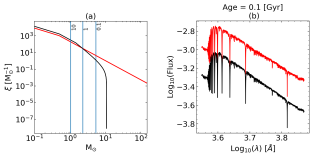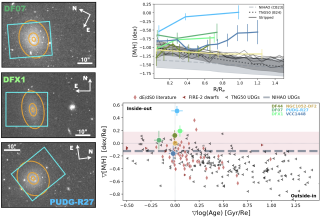We present photometric and spectroscopic observations of the members of three previously cataloged compact group (CG) candidatesat redshifts $z>0.3$. These confirm spectroscopic redshifts compatiblewith being gravitationally bound structures at redshifts 0.3112, 0.3848and 0.3643 respectively, and then they are the most distant CGs known with spectroscopic confirmation for all their members. The morphological and spectroscopic properties of all their galaxies indicate early types dominated by an old population of stars, with little star formation or nuclear activity. Most of the physical properties derived for the three groups are quite similar to the average properties of CGs at lower redshifts. In particular, from the velocities and positions of the respective members of each CG, we estimate short dynamic times. These leave open the questions of identifying the mechanism for forming CGs continuously and the nature of the final stages of these structures.
Advertised on
References
It may interest you
-
 Dormant black holes in X-ray transients can be identified by the presence of broad Hα emission lines from quiescent accretion discs. Unfortunately, short-period cataclysmic variables can also produce broad Hα lines, especially when viewed at high inclinations, and are thus a major source of contamination. Here we compare the full width at half maximum (FWHM) and equivalent width (EW) of the Hα line in a sample of 20 quiescent black hole transients and 354 cataclysmic variables (305 from SDSS I to IV) with secure orbital periods (Porb) and find that: (1) FWHM and EW values decrease with PorbAdvertised on
Dormant black holes in X-ray transients can be identified by the presence of broad Hα emission lines from quiescent accretion discs. Unfortunately, short-period cataclysmic variables can also produce broad Hα lines, especially when viewed at high inclinations, and are thus a major source of contamination. Here we compare the full width at half maximum (FWHM) and equivalent width (EW) of the Hα line in a sample of 20 quiescent black hole transients and 354 cataclysmic variables (305 from SDSS I to IV) with secure orbital periods (Porb) and find that: (1) FWHM and EW values decrease with PorbAdvertised on -
 We present, for the first time, model spectra of single-age, single-metallicity stellar populations computed with the E-MILES evolutionary synthesis code incorporating an environment-dependent, variable galaxy-wide initial mass function (gwIMF). This gwIMF, calculated using the GalIMF code, is rooted in the integrated galactic initial mass function (IGIMF) theory, which predicts IMF variations as a function of the star formation rate and the metallicity. By coupling these two codes, we generated a comprehensive library of single-burst stellar population spectra uniquely sensitive to gwIMFAdvertised on
We present, for the first time, model spectra of single-age, single-metallicity stellar populations computed with the E-MILES evolutionary synthesis code incorporating an environment-dependent, variable galaxy-wide initial mass function (gwIMF). This gwIMF, calculated using the GalIMF code, is rooted in the integrated galactic initial mass function (IGIMF) theory, which predicts IMF variations as a function of the star formation rate and the metallicity. By coupling these two codes, we generated a comprehensive library of single-burst stellar population spectra uniquely sensitive to gwIMFAdvertised on -
 Ultra-diffuse galaxies, an extreme type of dwarf galaxy, have been the focus of extensive observational and theoretical studies over the past decade. With stellar masses comparable to dwarf galaxies (between 10 7 and 10 9 solar masses) but much larger in size (as defined by their effective radius), they exhibit an extremely low surface brightness. These galaxies display highly diverse properties: some have large dark matter halos, others lack them, and their number of globular clusters varies widely. Studies of their kinematics and stellar populations have shown that these extreme galaxiesAdvertised on
Ultra-diffuse galaxies, an extreme type of dwarf galaxy, have been the focus of extensive observational and theoretical studies over the past decade. With stellar masses comparable to dwarf galaxies (between 10 7 and 10 9 solar masses) but much larger in size (as defined by their effective radius), they exhibit an extremely low surface brightness. These galaxies display highly diverse properties: some have large dark matter halos, others lack them, and their number of globular clusters varies widely. Studies of their kinematics and stellar populations have shown that these extreme galaxiesAdvertised on